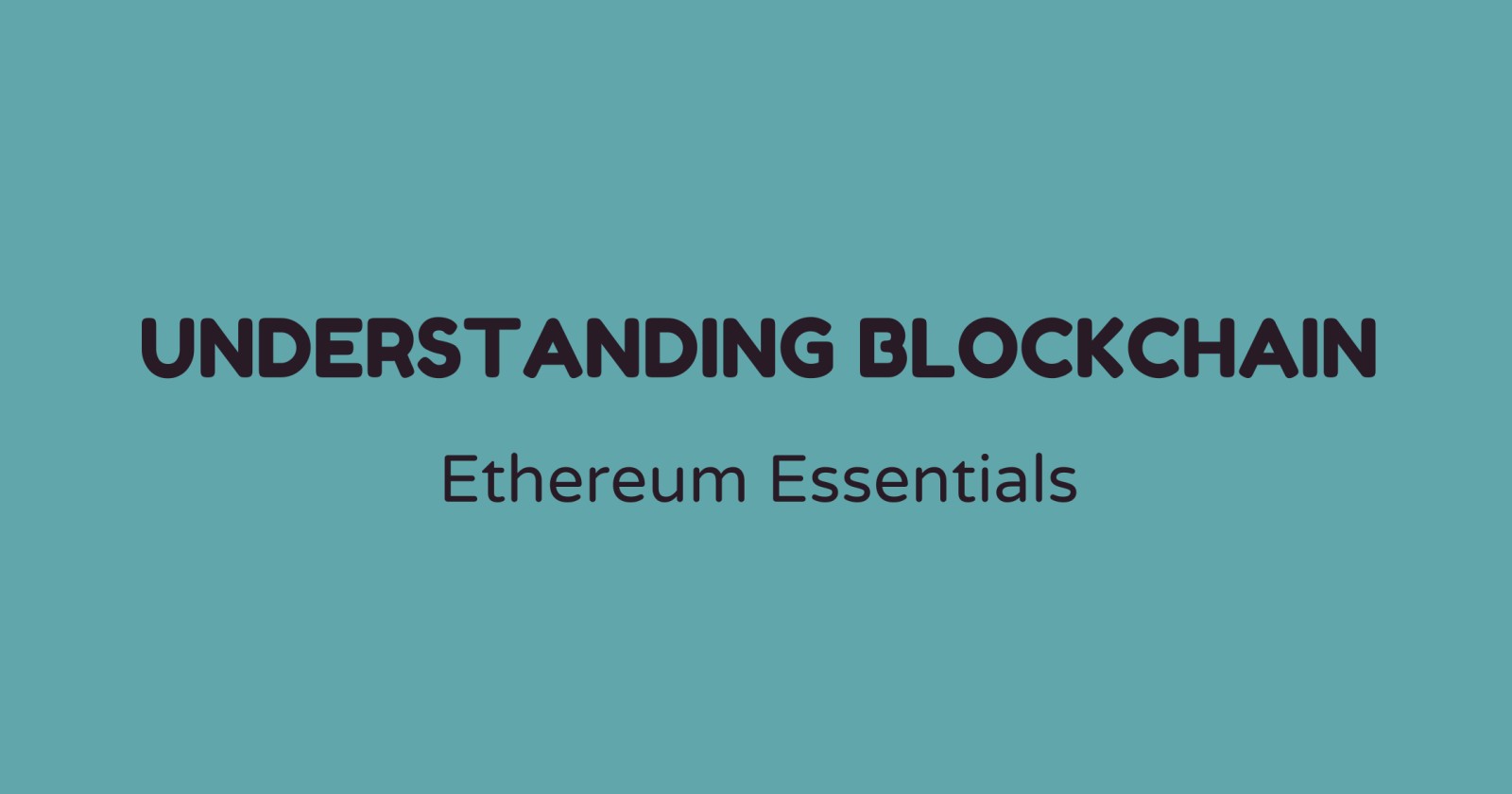Understanding Blockchain: Decentralisation, Security, and Beyond
 Gowtham Saravanan
Gowtham SaravananTable of contents
- The Essence of Blockchain: A Decentralized Digital Ledger
- Breaking Down the Blocks
- Fortifying Security with Cryptographic Techniques
- The Role of Nodes in Blockchain: Decentralization, Validation, and Security
- Resources for Further Exploration
- Unveiling the Real-World Impact: More Than Just Cryptocurrencies
- Outro

In the vast landscape of technological advancements, few concepts have captivated the world's attention as profoundly as blockchain. Often associated with cryptocurrencies, blockchain is a foundational technology that promises to revolutionize how we handle digital transactions, verify authenticity, and establish trust in an increasingly interconnected digital world. Join us on a deep dive into the intricacies of blockchain, unravelling its core principles, exploring its real-world implications, and uncovering the transformative potential it holds.
The Essence of Blockchain: A Decentralized Digital Ledger
Blockchain as a decentralized ledger offers a powerful way to maintain and verify information among multiple parties, promoting transparency, security, and trust without relying on a central authority.
Let's use an example involving three friends Alice, Bob, and Peter to illustrate how blockchain functions as a decentralized ledger.
Scenario: Shared Expenses
Imagine Alice, Bob, and Peter are roommates, and they want to keep track of shared expenses, ensuring fairness and transparency. In this scenario, blockchain serves as the decentralized ledger that records their financial transactions:
Setting Up the Blockchain
They decide to use a blockchain-based system to record their shared expenses. Each friend is a node in the blockchain network. A blockchain wallet is created for each of them, and this wallet holds their shares of the expenses.
Recording Transactions
Whenever any of them incurs an expense on behalf of the group, they record it as a transaction on the blockchain. For instance, if Alice buys groceries for $60, she records this transaction on the blockchain, specifying that the expense is for groceries, the amount, and the date.
Verification and Consensus
Once a transaction is recorded, it is broadcasted to the other friends' nodes on the blockchain network. Bob and Peter can verify the transaction and ensure its accuracy. This consensus mechanism ensures that all participants agree on the state of the shared expenses.
Immutable Ledger
Once a transaction is verified and added to the blockchain, it becomes part of an immutable and transparent ledger. No one can alter this record without consensus from the entire network. This immutability ensures that all participants can trust the historical record of expenses.
Equitable Settlements
Over time, as more shared expenses occur, the blockchain ledger continues to grow. Each participant can view the ledger and see a clear history of who paid for what. When it comes to settling expenses, they can use the blockchain's records to calculate everyone's share accurately. This eliminates disputes and ensures that everyone pays their fair share.
Decentralization and Security
The decentralized nature of the blockchain ensures that no single person (or central entity) controls the ledger. This eliminates the need for a trusted intermediary to keep track of expenses, reducing the risk of errors, bias, or manipulation. The security of the blockchain, based on cryptographic principles, ensures that the recorded transactions are tamper-proof.
In this shared expenses example, blockchain acts as a decentralized ledger, allowing Alice, Bob, and Peter to record, verify, and trust their financial transactions without relying on a centralized accounting system. This concept can be extended to various real-world scenarios, where multiple parties need to maintain an accurate and transparent record of transactions, assets, or information.
Breaking Down the Blocks
The core building blocks of blockchain are, well, blocks! These blocks are linked together in a chain, forming a continuous and unbreakable history of transactions. Each block contains a set of transactions, and crucially, a unique identifier called a cryptographic hash that binds it to the previous block, creating an unbreakable chain of interdependence. This structure ensures that every transaction is accountable and that no block can be altered without altering every subsequent block—imagine trying to change one page of a book without rewriting the entire book!
Blockchain Demo Website by Andres Brownworth
A block in the context of blockchain is a fundamental unit of data that stores a collection of transactions and other essential information. Each block is uniquely identified by a cryptographic hash, and these blocks are linked together in chronological order to form the blockchain. The structure of a block typically includes the following components:
Block Header - The header contains metadata about the block, such as the version of the blockchain protocol being used, a timestamp indicating when the block was created, the hash of the previous block (creating the chain), and a nonce (a number used in the mining process to achieve a specific hash value).
Transaction Data - This section contains a list of transactions that were confirmed and added to the block. In the case of Bitcoin, these transactions represent the movement of bitcoins from one address to another.
What is Mining a Block?
Mining a block is the process by which new blocks are added to the blockchain. It is a competitive process that involves network participants (miners) attempting to solve a complex mathematical puzzle. The primary objectives of mining are:
Transaction Verification - Miners verify the validity of transactions that have been broadcasted to the network. They check that the transactions adhere to the blockchain's rules, ensuring that the sender has sufficient funds, the cryptographic signatures are valid, and the transactions are unique (preventing double-spending).
Creating a New Block - Miners compete to find a specific value (nonce) that, when hashed together with the contents of the block, produces a hash value that meets certain criteria (e.g., a hash with a specific number of leading zeros in a proof-of-work system). The first miner to find this solution broadcasts the new block to the network.
%[https://www.youtube.com/watch?v=XLcWy1uV8YM]
Consensus Establishment - Once a miner successfully mines a block, the block is propagated throughout the network. Other nodes (participants) verify the validity of the block. If the block is valid, it is added to the blockchain. This process ensures consensus among network participants on the order of transactions and the state of the blockchain
Fortifying Security with Cryptographic Techniques
Blocks are linked together in a linear, chronological fashion, creating the blockchain. This linkage is achieved through the inclusion of a reference to the previous block's hash in each new block. Here's how it works:
A block is created, and its header includes a reference to the hash of the previous block in the chain.
Miners compete to mine this block, validating transactions and finding a valid nonce to create the block's unique hash.
Once the block is mined, it is broadcast to the network, and other nodes verify its validity.
If the block is deemed valid, it is added to the chain, becoming the latest block in the blockchain.
When the next block is mined, its header includes a reference to the hash of the previously added block, forming a chronological chain. This process continues for each new block added to the blockchain.
This linking mechanism ensures that altering the data in any block would invalidate all subsequent blocks, making the blockchain tamper-resistant and providing a transparent, secure, and immutable ledger of transactions.
The Role of Nodes in Blockchain: Decentralization, Validation, and Security
Nodes play a crucial role in the operation and security of a blockchain network. They are essential participants that collectively maintain the integrity, transparency, and consensus of the blockchain.
1. Network Participants
Nodes are active participants in the blockchain network. They can be individuals, organizations, or even devices connected to the network. Each node maintains a copy of the entire blockchain ledger. This decentralized distribution of copies ensures redundancy and helps in the network's resilience.
2. Data Validation and Consensus
One of the primary functions of nodes is to validate transactions and achieve consensus on the state of the blockchain. When a user initiates a transaction, it propagates through the network to be verified by multiple nodes. Nodes check the transaction's validity based on predefined rules, which typically involve verifying signatures, ensuring that the sender has sufficient funds, and confirming that the transaction adheres to the network's consensus rules.
3. Mempool Management
Nodes maintain a "mempool," a memory pool of unconfirmed transactions. When a user sends a transaction, it enters the mempool and waits to be included in a block by miners (or validators, depending on the consensus mechanism). Nodes in the network actively share information about the mempool, helping miners select transactions to include in the next block based on factors like transaction fees and priority.
4. Block Propagation
When miners (or validators) successfully mine a new block, they propagate it throughout the network. Nodes receive the new block, verify its contents, and, if valid, add it to their copy of the blockchain. This block propagation ensures that all nodes have an up-to-date view of the blockchain's state, maintaining consensus across the network.
5. Security and Decentralization
Nodes contribute to the security and decentralization of the blockchain network. The decentralized nature of blockchain is a result of multiple nodes across the globe maintaining copies of the blockchain. This distribution prevents a single point of failure, making the network more resilient to attacks.
In summary, nodes are essential components of a blockchain network, responsible for validating transactions, achieving consensus, maintaining the blockchain, and ensuring the network's security and decentralization. Their collective efforts contribute to the trust, transparency, and resilience of the blockchain ecosystem.
Resources for Further Exploration
Unveiling the Real-World Impact: More Than Just Cryptocurrencies
While blockchain's association with cryptocurrencies is significant, its impact extends well beyond digital coins. This technology has the potential to transform various industries, from supply chain management and healthcare to voting systems and identity verification. The transparent, tamper-proof nature of blockchain creates opportunities for increased efficiency, reduced fraud, and new business models.
Outro
In this journey through the intricacies of blockchain, we'll delve into the Ethereum platform, the innovation of smart contracts, the distinctions between different cryptocurrencies, the mechanics of transaction processing and gas fees, and even hands-on development. Our mission is to equip you with the knowledge and insights needed to navigate this dynamic and rapidly evolving landscape. Stay with us as we continue our exploration in the next post, where we'll uncover the essential elements of Ethereum.
Subscribe to my newsletter
Read articles from Gowtham Saravanan directly inside your inbox. Subscribe to the newsletter, and don't miss out.
Written by

Gowtham Saravanan
Gowtham Saravanan
Hello! I am Gowtham Saravanan 🙂, a professional Blockchain Developer upskilling myself in Smart Contract Development 📝 and other web3 technologies.